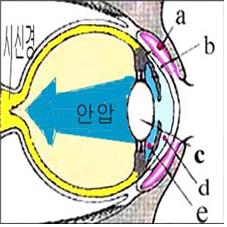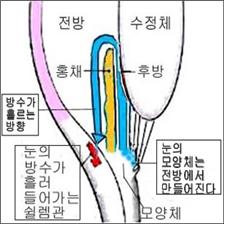녹내장 Glaucoma

그림 101. 녹내장으로 안압이 상승되면 시신경이 손상될 수 있다.
분흥색 부분이 결막이다
a-눈꺼풀 결막, b-안구 결막, c-수정체 , d-전방, e-후방

그림 102. 안구 속 방수가 정상적으로 생성되고 흡수되는 과정.
섬모체= 섬모체돌기(섬모돌기) + 섬모체근(섬모근)
참조문헌 Foundation for Glaucoma Research, San Francisco, USA
녹내장의 원인
-
안구 속의 압력을 안압이라고 한다.
-
안압이 정상 이상으로 높아서 눈병과 시력이상이 생기는 병을 녹내장이라고 한다.
-
렌즈와 각막의 사이에 있는 안구의 부분을 안구 전방과 안구 후방이라고 한다.
-
즉 각막의 바로 뒷면, 홍채의 바로 앞면에 있는 안구의 부분을 전방이라고 한다.
-
홍채의 뒷면과 렌즈의 앞면 사이의 안구의 부분을 후방이라고 한다(그림 103, 104, 105 참조).
-
정상적인 안구의 전방과 후방 속에 방수(房水)체액이 항상 들어 있다.
-
방수는 안구 속에 있는 모양돌기(섬모체)에서 끊임없이 분비된다.
-
모양돌기에서 분비된 방수는 후방 속을 거쳐 전방 속으로 정상적으로 흘러 들어간다.
-
전방으로 흘러온 방수는 전방우각(前房隅角)에 있는 슐렘관(Schlemms canal)을 통하여 핏속으로 흡수되는 것이 정상이다(그림 103, 104, 105 참조).
-
모양돌기에서 생성된 방수가 후방→전방→전방우각→슐렘관을 통과해서 핏속으로 흡수되고 생성되는 전 과정에 어떤 이상이 생길 때 안압이 높아져 녹내장이 생길 수 있다.
-
어떤 병으로 안구 속에 방수가 정상 이상으로 많이 괼 때, 또 방수가 정상적으로 분비되지만 정상적으로 핏속으로 흡수되지 않을 때는 안압이 정상 이상으로 높아지면서 녹내장이 생길 수 있다.
-
40세 이상의 성인들의 일부는 눈이 노쇠 되어 녹내장이 생길 가능성이 높다.
-
일반적으로 건강한 아이들의 눈에는 녹내장이 거의 생기지 않는다.
-
하지만 유전, 눈의 외상, 눈 속 출혈, 안구 속 종양, 눈의 염증, 갑상선 기능 항진증 등이 있으면 아이들에게도 녹내장이 생길 수 있다.
-
녹내장에는 우각 폐쇄성 녹내장과 우각 개방성 녹내장으로 나눌 수 있고 급성 녹내장 또는 만성 녹내장 등으로 나눌 수 있다.
-
우각 폐쇄성 녹내장은 드물게 생길 수 있지만 보통 속성으로 생기고 방수가 흡수되는 눈 부위가 갑자기 막혀 생긴다.
-
시력이 희미해지고 두통, 구토, 안통 등의 증상이 생긴다.
-
우각 개방성 녹내장은 더 흔한 녹내장이고 서서히 생기는 것이 보통이고 연만한 성인들에게 더 잘 생길 수 있다.
-
방수가 정상적으로 흡수되지 않아 안구 내에 방수가 많이 차 안압이 비정상적으로 올라간다.
-
점차로 시력이 감소될 수 있다.
-
말초시력 장애가 쉽게 온다.
녹내장 증상 징후
- 녹내장의 원인과 정도, 급성 녹내장 또는 만성의 녹내장에 따라 증상 징후가 다르다.
- 안구 속 압이 정상보다 약간 높은 녹내장은 아무런 증상 징후가 나타나지 않을 수 있다.
- 그렇지만 안압이 점점 더 증가되어 심한 녹내장이 생길 때는 각막이 앞으로 불쑥 밀려나올 수 있다. 그리고 동공이 비정상적으로 더 커져 안구가 소의 눈 같이 커질 수 있다.
-
이렇게 커진 눈알을 우안(牛眼)이라고 한다.
-
녹내장이 있는 안구 속 방수가 비정상적으로 많이 차 있기 때문에 녹내장을 수안증(水眼症)이라고도 한다.
-
녹내장으로 안압이 점점 더 높아질 때 안구의 맨 뒤 부위에 있는 시신경(시각 신경)에 위축이 생겨 시력 장애 내지 시력 상실이 생길 수 있다.
-
녹내장이 있는 눈에서 눈물이 많이 나고 햇빛이나 불빛에 눈이 부시고 각막이 부어 각막이 혼탁 될 수 있다.
-
병력·증상 징후와 진찰소견 등을 종합하여 이 병이 의심되면 안과 전문의의 진단을 받아야 한다.

그림 105. 안구 방수가 분비되고 배수되는 과정
녹내장 치료
-
녹내장의 정도, 녹내장을 일으킨 원인 등에 따라 치료가 다르다.
-
녹내장이 있으면 안과 전문의의 치료를 받아야 한다.
-
모양돌기(섬모체)에서 방수를 조금 덜 만들어 내게 하는 약으로 치료할 수 있다.
-
수술치료와 안약치료 이 두 가지로 치료하기도 한다.
-
수술로 치료하지 않고 레이저 광선으로 치료할 수 있다.
Glaucoma 녹내장

Figure 101. Elevated intraocular pressure with glaucoma can damage the optic nerve. The purple part is the conjunctiva a – eyelid conjunctiva, b – ocular conjunctiva, c – lens , d – anterior, e – posterior

Figure 102. The normal production and absorption of aqueous humor in the eye. Ciliary body = ciliary process (ciliate process) + ciliary muscle (ciliary muscle) References Foundation for Glaucoma Research, San Francisco, USA
Causes of glaucoma
• The pressure inside the eyeball is called intraocular pressure.
• Glaucoma is a disease that causes eye disease and vision abnormalities due to excessively high intraocular pressure.
• The part of the eye between the lens and the cornea is called the anterior chamber and the posterior eye.
• That is, the part of the eyeball that is directly behind the cornea and in front of the iris is called the anterior chamber.
• The part of the eyeball between the back of the iris and the front of the lens is called posterior (see Figures 103, 104, 105).
• There is always aqueous humor in the anterior and posterior chambers of the normal eyeball.
• The aqueous humor is constantly secreted from the ciliary process (ciliary body) in the eyeball.
• The aqueous humor secreted from the ciliary process normally flows into the anterior chamber through the posterior chamber.
• It is normal for the aqueous humor that flows forward to be absorbed into the blood through the Schlemms canal in the anterior right leg (see Fig. 103, 104, 105).
• The aqueous humor generated from the ciliary process passes through the posterior-anterior → anterior right angle → Schlem’s canal and is absorbed into the blood.
• When the aqueous humor in the eye becomes larger than normal due to some disease, or when aqueous humor is secreted normally but not absorbed into the blood normally, the intraocular pressure rises above normal and glaucoma may occur.
• Some adults over the age of 40 are more likely to develop glaucoma due to senescence of the eyes. • Glaucoma rarely develops in the eyes of generally healthy children.
• However, genetics, eye trauma, eye bleeding, eye tumors, eye inflammation, and hyperthyroidism can also cause glaucoma in children.
• Glaucoma can be divided into right-angle closure glaucoma and right-angle open glaucoma, and can be divided into acute glaucoma or chronic glaucoma.
• Right angle obstructive glaucoma, although rare, usually occurs spontaneously and is caused by sudden blockage of the area of the eye where aqueous humor is absorbed.
• Blurred vision and symptoms such as headache, vomiting and eye pain.
• Right angle open glaucoma is the more common type of glaucoma and usually develops slowly and may occur more often in younger adults.
• Because the aqueous humor is not absorbed normally, there is a lot of fluid in the eyeball, and the intraocular pressure rises abnormally.
• You may gradually lose sight.
• Peripheral vision impairment comes easily.
Glaucoma Symptoms Signs
• Symptoms and signs differ depending on the cause and severity of glaucoma, acute glaucoma or chronic glaucoma.
• Glaucoma, in which the intraocular pressure is slightly higher than normal, may not cause any symptoms.
• However, the cornea can protrude forward when the pressure in the eye gradually increases, resulting in severe glaucoma. And the pupil can become abnormally large, making the eyeball as large as that of a cow’s eye.
• This enlarged eyeball is called the right eye.
• Glaucoma is also called hydrophthalmia (水眼症) because the aqueous humor in the eye with glaucoma is abnormally filled.
• When intraocular pressure increases with glaucoma, atrophy of the optic nerve (optic nerve) at the back of the eyeball can result in visual impairment or loss of vision.
• Eyes with glaucoma may produce tears, glare from sunlight or light, and swelling of the cornea, which may make the cornea cloudy.
• If this disease is suspected based on medical history, symptoms, signs, and examination findings, an ophthalmologist should be consulted.

Figure 105. The process by which aqueous humor is secreted and drained
Glaucoma Treatment
• Treatment varies depending on the degree of glaucoma and the cause of the glaucoma.
• If you have glaucoma, you should see an eye care professional.
• It can be treated with drugs that make the ciliary process (ciliate body) slightly less aqueous.
• There are two types of treatment: surgery and eye drops.
• Can be treated with laser beams without surgery.
출처 및 참조문헌
- www.drleepediatrics.com 제 6권 신생아 성장 발육 육아 질병
-
www.drleepediatrics.com제7권 소아청소년 감염병
- www.drleepediatrics.com제8권 소아청소년 호흡기 질환
- www.drleepediatrics.com제9권 소아청소년 소화기 질환
- www.drleepediatrics.com제10권. 소아청소년 신장 비뇨 생식기 질환
- www.drleepediatrics.com제11권. 소아청소년 심장 혈관계 질환
- www.drleepediatrics.com제12권. 소아청소년 신경 정신 질환, 행동 수면 문제
- www.drleepediatrics.com제13권. 소아청소년 혈액, 림프, 종양 질환
- www.drleepediatrics.com제14권. 소아청소년 내분비, 유전, 염색체, 대사, 희귀병
- www.drleepediatrics.com제15권. 소아청소년 알레르기, 자가 면역질환
- www.drleepediatrics.com제17권. 소아청소년 피부 질환
- www.drleepediatrics.com제18권. 소아청소년 이비인후(귀 코 인두 후두) 질환
- www.drleepediatrics.com제19권. 소아청소년 안과 (눈)질환
- Red book 29th-31st edition 2021
- Nelson Text Book of Pediatrics 19th — 21st Edition
- The Johns Hopkins Hospital, The Harriet Lane Handbook, 22nd edition
-
Childhood Emergencies in the Office, Hospital and Community, American Academy of Pediatrics
-
Emergency Medical Service for Children, By Ross Lab. May 1989. p.10
-
Emergency care, Harvey grant, and Robert Murray
-
Emergency Care Transportation of Sick and Injured American Academy of Orthopaedic Surgeons
-
Emergency Pediatrics A Guide to Ambulatory Care, Roger M. Barkin, Peter Rosen
-
Immediate care of the acutely ill and injured, Hugh E. Stephenson, Jr
-
The Critically Ill Child, Diagnosis and Management, Edited by Clement A. Smith
-
Emergency Medical Services for Children: The Role of the Primary Care Provider, America Academy of Pediatrics
-
Quick Reference To Pediatric Emergencies, Delmer J. Pascoe, M.D., Moses Grossman, M.D. with 26 contributors
-
Manual of Emergency Care
-
응급환자관리 정담미디어
-
소아가정간호백과–부모도 반의사가 되어야 한다, 이상원
-
Neonatal Resuscitation American heart Association
-
Neonatology Jeffrey J.Pomerance, C. Joan Richardson
-
Pediatric Resuscitation Pediatric Clinics of North America, Stephen M. Schexnayder, M.D.
-
Pediatric Critical Care, Pediatric Clinics of North America, James P. Orlowski, M.D.
-
Preparation for Birth. Beverly Savage and Dianna Smith
- Infectious disease of children, Saul Krugman, Samuel L Katz, Ann A. Gershon, Catherine Wilfert
-
The Harriet Lane Handbook 19th Edition
-
소아과학 대한교과서
-
제1권 소아청소년 응급의료 참조문헌과 출처
-
Other
Copyright ⓒ 2015 John Sangwon Lee, MD., FAAP
“부모도 반의사가 되어야 한다”-내용은 여러분들의 의사로부터 얻은 정보와 진료를 대신할 수 없습니다.
“The information contained in this publication should not be used as a substitute for the medical care and advice of your doctor. There may be variations in treatment that your doctor may recommend based on individual facts and circumstances. “Parental education is the best medicine.”